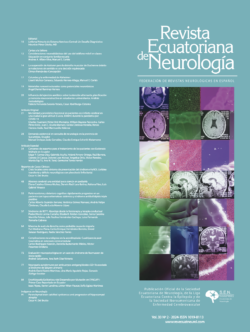Artículo original
The postural instability in hemiparkinsonian rats is ameliorated by intrastriatal implants of SiO2-DA. La inestabilidad postural en las ratas hemiparkinsonianas es reducida por implantes intraestriatales de SiO2-DA.
Autor: José L. Bata-García, Dulce M. Esquivel-Gómez, Carlos E. Pérez-Osorio, Ángel S. Castilla-Tirado, Luis A. Estrada LoyoRev. Ecuat. Neurol. VOL 33 Nº1, 2024
La enfermedad de Parkinson (EP) es una enfermedad crónica con pérdida de neuronas dopaminérgicas de la sustancia negra pars compacta (SNpc) que causa deterioro motor.
El objetivo de este estudio fue evaluar el efecto de la liberación intraestriatal de dopamina (DA) de reservorios de SiO2 sobre la asimetría postural en animales hemiparkinsonianos.
Se utilizaron dos pruebas motoras con relevancia clínica: la Prueba de Ajuste de pasos y la Prueba de Cilindro durante exploración vertical. Se formaron tres grupos: animales sin implante (L), con implante de SiO2 sin DA (SiO2) y con implante de SiO2 con DA (SiO2-DA).
Todas las ratas mostraron deterioro significativo de hasta 80% (p < 0,0001) en la ejecución de los pasos con la pata anterior contralateral (PAC), sin afectación de la ipsilateral (PAI) y únicamente el grupo SiO2-DA recuperó la simetría al 100% en el ajuste de pasos entre ambas patas.
En el cilindro solo el grupo SiO2-DA redujo significativamente (p < 0,0001) el deterioro en el uso de la PAC durante exploración vertical. No se observó tolerancia ni discinesias en el tiempo del estudio.
Estos resultados mostraron que los reservorios de SiO2-DA son seguros y una alternativa terapéutica prometedora contra la EP.
Parkinson’s disease (PD) is a chronic disease with loss of dopaminergic neurons of the substantia nigra pars compacta (SNpc) causing motor impairment.
The objective of this study was to evaluate the effect of the intrastriatal release of dopamine (DA) from SiO2 reservoirs on postural asymmetry in hemiparkinsonian animals.
This study compares groups of rats without an implant (L), with empty SiO2 implant (SiO2), and with SiO2 implant plus DA (SiO2-DA) to assess motor and clinical relevance during vertical exploration using the Steps Adjustment and the Cylinder tests.
All rats showed significant deterioration of up to 80% (p < 0.0001) in the execution of the steps with the contralateral forelimb (CF), without affectation of the ipsilateral forelimb (IF) and only the SiO2-DA group recovered 100% symmetry in the adjustment of steps between both forelimbs.
In the cylinder, only the SiO2-DA group significantly reduced (p < 0.0001) the deterioration in the use of CF during vertical exploration. No tolerance or dyskinesias were present at the time of the study.
These results showed that SiO2-DA reservoirs are safe and a promising therapeutic alternative against PD.





